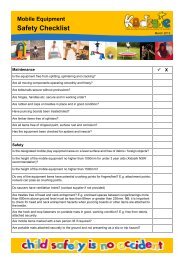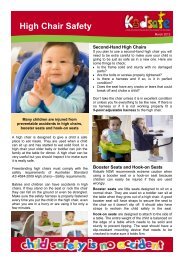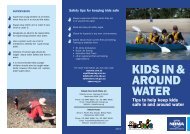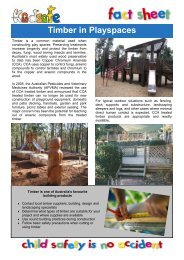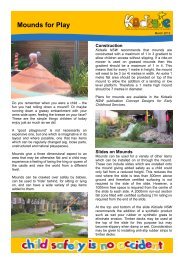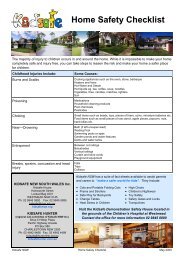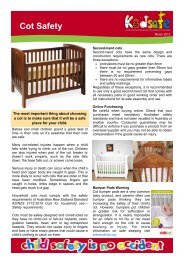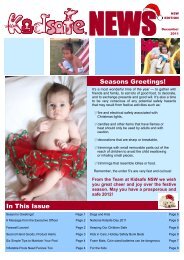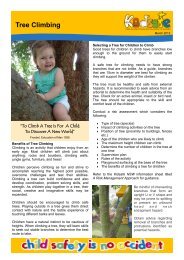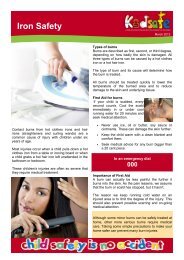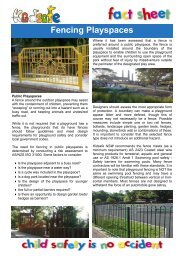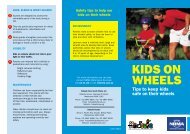Playing Safe - Kidsafe NSW
Playing Safe - Kidsafe NSW
Playing Safe - Kidsafe NSW
Create successful ePaper yourself
Turn your PDF publications into a flip-book with our unique Google optimized e-Paper software.
<strong>Playing</strong><br />
<strong>Safe</strong>:<br />
Guidelines for<br />
the installation<br />
and maintenance<br />
of playground<br />
equipment in<br />
<strong>NSW</strong> government<br />
schools
<strong>Playing</strong> <strong>Safe</strong>: Guidelines for the installation and<br />
maintenance of playground equipment in <strong>NSW</strong><br />
government schools.<br />
© 2006 <strong>NSW</strong> Department of Education and Training<br />
Asset Management Directorate<br />
Additional copies may be purchased from:<br />
Education Facilities Research Group<br />
Level 20 McKell Building<br />
2 – 24 Rawson Place<br />
Sydney <strong>NSW</strong> 2001<br />
Telephone (02) 9372 8510<br />
Email efrg@commerce.nsw.gov.au<br />
ISBN 0731385039<br />
SCIS 128148<br />
Graphic design: BIAGDESIGN
<strong>Playing</strong> <strong>Safe</strong>: Guidelines for the installation<br />
and maintenance of playground equipment in<br />
<strong>NSW</strong> government sch o o l s<br />
Preamble<br />
This Government is committed to the physical wellbeing of all<br />
students while using playground equipment in <strong>NSW</strong> schools. These<br />
guidelines are designed to ensure the provision of a safe environment<br />
for the physical development and recreation of students and community<br />
members.<br />
The importance of play in the development of students and young<br />
people has been well documented over the years. As well, research<br />
shows that for some young people schools are the only place where<br />
they can participate in physical activity. More recently, attention has<br />
been focussed on childhood obesity within the school-age population<br />
in Australia.<br />
With the release of the new Australian Standards for Playgrounds, it<br />
has become necessary to issue updated guidelines for the installation<br />
and maintenance of playground equipment in <strong>NSW</strong> government<br />
schools. This document replaces <strong>Safe</strong>ty guidelines for the installation<br />
and maintenance of fixed playground equipment in schools (1999).<br />
As the Department does not supply playground equipment to schools,<br />
these guidelines are designed to assist schools to ensure that a safe<br />
environment is provided for the physical development and recreation<br />
of students.
C o n t e n t s<br />
1. Introduction 7<br />
1.1. The safe playground 7<br />
1.2. New standards for playground equipment 8<br />
1.3. Differences between the old and new standards 8<br />
2. Planning your school’s playground equipment 10<br />
2.1. Setting the context 10<br />
2.2. Identifying the location 10<br />
2.3. Equipment selection 11<br />
3. Rules and regulations 13<br />
3.1. Equipment 13<br />
3.2. Banned equipment 13<br />
3.3. Approval process 14<br />
3.4. Responsibility of designers and manufacturers 14<br />
3.5. Responsibility of installers 15<br />
4. <strong>Safe</strong>ty considerations 16<br />
4.1. Installation 16<br />
4.2. Impact-absorbing surfaces 20<br />
4.3. Track rides 21<br />
4.4. Existing equipment 21<br />
4.5. Introduction to new equipment 21<br />
4.6. Use of equipment 22<br />
5. Maintenance essentials 23<br />
6. Sources of information 24<br />
7. Appendices 25<br />
7.1. Planning your playground: Checklists 25<br />
7.2. Playground safety audit 28<br />
7.3. On-going maintenance checklist 30<br />
7.4. Impact-absorbing materials 31<br />
7.5. Sample report form: Accident to school student 32<br />
<strong>Playing</strong> <strong>Safe</strong>: Guidelines for the installation and maintenance of playground equipment in <strong>NSW</strong> government schools 5
6<br />
<strong>Playing</strong> <strong>Safe</strong>: Guidelines for the installation and maintenance of playground equipment in <strong>NSW</strong> government schools
1 I n t ro d u c t i o n<br />
1.1. The safe playground<br />
A safe playground is an essential element of a safe school. Most students will use<br />
the playground at some time during the day and it is essential that all risks are<br />
identified and addressed.<br />
The Department of Education and Training’s Occupational Health and <strong>Safe</strong>ty Policy<br />
outlines the responsibilities of managers, supervisors and employees to provide for<br />
all staff, students and visitors a healthy, safe and orderly environment in which to<br />
work and learn.<br />
As part of its risk management strategy, the Department has developed this<br />
document in order to provide schools with guidance in relation to the installation of<br />
fixed playground equipment. This document is a revision of <strong>Safe</strong>ty guidelines for the<br />
installation and maintenance of fixed playground equipment in schools (1999).<br />
The supervisors and users of the playground will develop best practices and<br />
controls. Schools will develop policies and guidelines in consultation with staff,<br />
students and parents.<br />
Fixed playground equipment is only one component of a school playground. School<br />
communities should gather information and seek advice on playground design before<br />
proceeding with the purchase of expensive fixed equipment. If equipment is to be<br />
purchased, it should be part of the overall playground plan and suitably located.<br />
It will then become an integral part of the play experience.<br />
The checklist that appears in this document will assist schools to identify risks<br />
within playgrounds. The items on the list are not exhaustive and the assessment of<br />
risks should take into account the strategies that appear in Risk management<br />
awareness training for principals and Asset protection training program.<br />
If you have any enquiries regarding the Department’s policy on playgrounds or<br />
playground equipment, please contact the Asset Management Unit in your region.<br />
<strong>Playing</strong> <strong>Safe</strong>: Guidelines for the installation and maintenance of playground equipment in <strong>NSW</strong> government schools 7
1.2 New standards for playground equipment<br />
All new playground equipment must comply with the current Australian and New Zealand standards.<br />
The new playground standards are AS 4685 Parts 1-6, 2004, which should be read in conjunction with the<br />
current product and risk management standards, AS/NZS 4486 and AS/NZS 4422.<br />
All new playground<br />
equipment must comply<br />
with the current Australian<br />
and New Zealand standards.<br />
1.3 Differences between the old and new standards<br />
The key changes are as follows:<br />
• For the new standard in six parts AS4685 – General, Swings (banned), Slides, Runways,<br />
Carousels (banned), and Rocking Equipment – there is no maximum equipment height<br />
(previously 6.0 metres).<br />
• Protection against falling:<br />
– Maximum free height of fall is limited to 2.5 metres.<br />
8<br />
<strong>Playing</strong> <strong>Safe</strong>: Guidelines for the installation and maintenance of playground equipment in <strong>NSW</strong> government schools
– Maximum height of upper body/overhead equipment is limited to 2.2 metres.<br />
– New terminology has been adopted for the ‘height of fall’ definition, which is termed free<br />
height of fall. The initial wording, ‘reasonably foreseeable access’ has been removed.<br />
• ‘Forced movement’ principle:<br />
– Impact of the ‘forced movement’ principle and its fall zones. Impact attenuation is required<br />
for surfaces on lower decks (where deck-to-deck height exceeds 1.0 metre). ‘Forced<br />
movement’ is defined as ‘the displacement of a user that is forced, restricted or limited by<br />
the construction of the playground equipment’.<br />
• Static equipment zones:<br />
– Reduced zone dimensions apply where equipment has free heights of fall less than 2.5<br />
metres. This includes slides, tracks, track rides and spring rockers.<br />
• Protection against entrapment:<br />
– Clearly defined entrapment conditions, tests and dimensions for finger, foot, torso, head,<br />
neck, and toggle.<br />
• Design considerations:<br />
– Minor structural design changes.<br />
• Guardrails and handrails:<br />
– Minor changes in the provision of guardrails on equipment platforms.<br />
– Requirement for a safety rail across all access points for slides higher than one metre<br />
to prevent accidental falls.<br />
<strong>Playing</strong> <strong>Safe</strong>: Guidelines for the installation and maintenance of playground equipment in <strong>NSW</strong> government schools 9
2 Planning your sch o o l ’s playground equipment<br />
2.1. Setting the context<br />
Choosing playground equipment<br />
It is important to explore the needs of the school and its community before a decision is made to acquire<br />
equipment.<br />
The choice of equipment and the design of its layout are determined by a school’s environment. Needs<br />
differ between schools and therefore equipment selection and layout will vary between schools.<br />
The choice of equipment should involve consultation with the whole school community, especially if there<br />
are programs that include community use of the school’s facilities.<br />
Age group<br />
The age group of the students for whom the equipment<br />
is to be provided will determine many features of the<br />
design.<br />
Where possible, the playground equipment should be<br />
designed specifically for particular ages or groups.<br />
Consideration should be given to the limitations of<br />
younger students (e.g. platform heights) and the need<br />
for greater challenge for older students.<br />
Falls from playground<br />
equipment are the most<br />
common cause of<br />
childhood injuries.<br />
Physical development and recreation<br />
The type of development to be achieved should be clearly defined to establish the type of equipment<br />
required. It should be decided whether gross-motor skills, co-ordination and balance and/or therapy<br />
requirements, in the case of a special school, are to be achieved.<br />
The proportion of use for physical development compared to recreational use is an important consideration.<br />
After hours<br />
It is important, when considering the design of equipment, to recognise that the equipment may be used by<br />
students of all ages and stages of physical development and condition, with or without supervision, during<br />
hours when the school is unoccupied.<br />
2.2. Identifying the location<br />
Consider and eliminate locations where potential intrusions into the safety zones of equipment areas occur,<br />
such as shade structure posts, fencing, gates and trees, landscaping, taps and other services. These items<br />
also include the soft-fall edging itself. It is important to measure the site twice to ensure that the space<br />
provided for the equipment is actually available and that the site topography can safely accommodate<br />
the equipment.<br />
The site for the fixed equipment should allow a 2.5 metre clearance from the perimeter of equipment in<br />
school playgrounds or a 1.9 metre clearance for supervised early childhood settings (see 4.1. Installation).<br />
10<br />
<strong>Playing</strong> <strong>Safe</strong>: Guidelines for the installation and maintenance of playground equipment in <strong>NSW</strong> government schools
When determining locations, consideration should be given to possible future extensions of the equipment<br />
and/or nearby buildings to ensure sufficient area is available. The site should preferably be shaded<br />
(see Sun safe policy).<br />
Consideration for, and consultation with, adjoining neighbours should occur if the playground equipment is<br />
to be installed where neighbours could be affected (e.g. visual or noise impact).<br />
Site requirements<br />
Care should be taken to ensure that the site chosen is free of easements, power lines, water, gas, drainage<br />
or other services and is not intended for future permanent buildings or demountables.<br />
Topography<br />
The site should be reasonably level, with only a gentle slope at most.<br />
Vegetation and ground cover<br />
Growth around the site selected for the equipment should not be such that extensive removal of trees and<br />
shrubs is necessary to obtain the required 2.5 metre clearance. Where trees must be removed, appropriate<br />
council permits should be obtained beforehand. It is very important that the area be free from rocks, stones,<br />
pipes, other rubble and tree stumps.<br />
Drainage<br />
Where possible, the area selected should be self-draining to avoid the need to restrict use for extended<br />
periods of time following wet weather. Adequate provision should be made for drainage.<br />
Supervision and security<br />
The site should be easily supervised<br />
and should provide adequate open<br />
views from occupied areas of the<br />
school and, if possible, from adjoining<br />
properties.<br />
Traffic flow<br />
The site should not interrupt normal<br />
lines of movement within the school<br />
grounds or inhibit other play areas.<br />
2.3. Equipment selection<br />
The first step in equipment selection is to decide whether or not fixed playground equipment is needed at<br />
the school. This involves consideration of the purpose for which the equipment will be used.<br />
Once it has been decided whether the equipment required is adventure playground, gross-motor track,<br />
gymnastic or a combination of the above, the individual items may be selected.<br />
Commercial equipment<br />
Playground injuries account for 16% of<br />
paediatric admissions to hospitals in <strong>NSW</strong><br />
(<strong>NSW</strong> Health Department, 1993). They are<br />
the most common cause of admission to<br />
hospital for early childhood in the 5 to 9<br />
years age group.<br />
Commercially produced playground equipment is available on government contract. Items approved for<br />
schools have been through a formal evaluation process to assess their suitability. (Contract 305 –<br />
Outdoor and recreational furniture)<br />
<strong>Playing</strong> <strong>Safe</strong>: Guidelines for the installation and maintenance of playground equipment in <strong>NSW</strong> government schools 11
Funding<br />
The source of funding must be clearly identified before inviting suppliers to quote.<br />
Material<br />
The type of equipment selected will influence the material used for construction and maintenance of the<br />
equipment.<br />
To reduce the risk of vandalism, consideration should be given to the type of materials chosen, e.g. vandals<br />
could slash rope-scrambling nets. Exposure of certain materials to the elements is another factor to be<br />
considered.<br />
12<br />
<strong>Playing</strong> <strong>Safe</strong>: Guidelines for the installation and maintenance of playground equipment in <strong>NSW</strong> government schools
3 Rules and re g u l a t i o n s<br />
3.1. Equipment<br />
Specifications<br />
Existing equipment: All existing equipment must comply with AS 1924-1981. However, when modification<br />
occurs to existing equipment then such equipment must be brought into full compliancy with AS 4685.<br />
All equipment and impact-absorbing materials should conform to the current Australian standards for<br />
playground equipment. The Department considers Australian standards to be a minimum requirement.<br />
The following specifications should be met when designing, selecting and installing equipment on<br />
Departmental premises.<br />
AS/NZS 4486. 1:1997<br />
Playground and playground equipment<br />
Part 1: Development, installation, inspection, maintenance and operation<br />
AS/NZS 4422: 1996<br />
Playground surfacing<br />
Specifications, requirements and test methods<br />
Note: It is usually not necessary to purchase these documents. Ask the supplier if the equipment or<br />
impact-absorbing material being considered complies with these standards, and to provide a written<br />
statement to that effect. If a school community group decides to install equipment rather than purchase<br />
it from a manufacturer or supplier, it must ensure that the equipment and its installation meet these<br />
standards, and the design should be verified by an engineer.<br />
Use of CCA (Copper chromium arsenate ‘Treated Pine’) timber:<br />
The installation of new equipment made from CCA timber is banned in <strong>NSW</strong> schools.<br />
3.2. Banned equipment<br />
Because of the potential risk of injury, the following items of equipment are banned from use in<br />
Departmental premises:<br />
Swings:<br />
Seesaws<br />
Roundabouts (carousels)<br />
Maypoles<br />
Flying foxes:<br />
All types, including swinging ropes and tyres (some items for students with<br />
disabilities may be exempt in specific settings).<br />
except in the case of Field Study Centres or non-mainstream school locations given<br />
written approval by the relevant Asset Management Unit manager.<br />
<strong>Playing</strong> <strong>Safe</strong>: Guidelines for the installation and maintenance of playground equipment in <strong>NSW</strong> government schools 13
It is estimated that the cost<br />
for falls injury from playground<br />
equipment is approximately<br />
$11 million per year.<br />
3.3. Approval process<br />
There is a two-step approval process to be completed before equipment is purchased.<br />
Step One<br />
• The approval of a detailed plan by the principal is required prior to the installation of fixed<br />
playground equipment in school grounds.<br />
The plan should include:<br />
• position of equipment relative to buildings, drains, trees, fences, paths, gates, roads, walls,<br />
watercourses and other equipment;<br />
• definitive measurements;<br />
• the items of equipment to be installed;<br />
• distances between items, clearance from containment borders and other objects, height of<br />
platforms and overall heights, materials used for construction and sizes of components;<br />
• the type of impact-absorbing surface and border;<br />
• safety issues;<br />
• maintenance issues;<br />
• source of funding, costs, payment schedule, installation time, supplier, who is to install and the<br />
projected completion date;<br />
• proposed inspection and maintenance schedule;<br />
• cleaning requirements;<br />
• the purpose for which the equipment is intended, e.g. physical development and educational use;<br />
• an outline of the policies and programs required to ensure the safe introduction and continued<br />
operation of the proposed equipment.<br />
Step Two<br />
• The siting of fixed playground equipment in school grounds is to be approved by the manager<br />
of your Asset Management Unit. This is also to confirm that the proposal to install fixed<br />
equipment does not affect future capital works projects, access for the provision or removal of<br />
demountables or any other property-related matters.<br />
Before purchasing equipment or commencing installation, the principal must approve a detailed plan.<br />
3.4. Responsibility of designers and manufacturers<br />
Equipment designers have a responsibility under a general duty of care to ensure that the playground<br />
equipment satisfies all of the requirements of the playground standards. In the event of an injury, death or<br />
equipment failure they can be held liable for negligence. They are required to provide legible manufacturing<br />
details marked on all equipment, plus their ABN, equipment reference and year of manufacture.<br />
14<br />
<strong>Playing</strong> <strong>Safe</strong>: Guidelines for the installation and maintenance of playground equipment in <strong>NSW</strong> government schools
Designers and manufacturers of equipment are also responsible for the provision of installation instructions<br />
to ensure that the completed installation, when undertaken in accordance with instructions, satisfies all the<br />
requirements of the standards, particularly with regard to structural integrity and entrapment potential.<br />
3.5. Responsibility of installers<br />
Playground installers have a responsibility to ensure that the installation is carried out strictly in accordance<br />
with the recommendations and instructions of the manufacturer. If injury, death or equipment failure occurs<br />
as a result of failure to install equipment in accordance with instructions, the installer will be considered<br />
negligent.<br />
If a supplier installs equipment, final payment should not be made until the principal is satisfied that the<br />
equipment meets these guidelines. The principal should receive a letter from the supplier confirming that<br />
the equipment and/or impact-absorbing surface meet current Australian standards.<br />
<strong>Playing</strong> <strong>Safe</strong>: Guidelines for the installation and maintenance of playground equipment in <strong>NSW</strong> government schools 15
4 <strong>Safe</strong>ty considera t i o n s<br />
All equipment installed on Departmental premises becomes Departmental property. The Department may<br />
be responsible for any injury or incident occurring from the use of this equipment by either authorised or<br />
unauthorised persons.<br />
Any accidents or incidents involving playground equipment should be reported and investigated in<br />
accordance with Departmental instructions. Particular attention should be paid to any recurring types of<br />
accident or incident involving playground equipment.<br />
A formal system of recording injuries will ensure that ‘black spots’ are identified and problems rectified.<br />
For a sample accident form see Appendix 7.5.<br />
4.1. Installation<br />
Schools need to seriously consider how the equipment will be installed. Whoever installs the equipment<br />
must be familiar with the requirements of the standards, especially entrapment and fall zone provisions.<br />
Installation option<br />
• Supplier installed<br />
• School installed/supplier supervised<br />
• School installed and supervised<br />
Considerations/comments<br />
• Supplier is familiar with requirements of<br />
the standards<br />
• Some suppliers may insist that company<br />
representatives supervise the installation<br />
• Some suppliers may insist that an inspection<br />
of the completed installation be undertaken<br />
prior to use<br />
• Ensure that the skills, labour and equipment<br />
are available to install the equipment to the<br />
Australian standards<br />
• There is a risk that schools installing<br />
manufactured equipment may void<br />
warranties and consequently incur legal<br />
liabilities for the Department<br />
Remember: The part of the school site where the installation or maintenance of the equipment is occurring<br />
becomes a workplace and therefore all occupational health and safety requirements apply.<br />
16<br />
<strong>Playing</strong> <strong>Safe</strong>: Guidelines for the installation and maintenance of playground equipment in <strong>NSW</strong> government schools
Sloping ground<br />
Often on site there may be an issue with the slope of the ground. If it is a large installation, the equipment<br />
effectively rises out of the ground as it is installed down the slope, and this may inadvertently increase free<br />
height of fall of the equipment.<br />
Borders<br />
A distinct border to indicate separation from the balance of the playground space should surround the area<br />
occupied by the fixed playground equipment. Borders may be a fence or a border of logs. It is important<br />
that the selected border does not become a trip hazard. The border may be above ground (at least one step<br />
high), or flush with the ground.<br />
Clearances/<strong>Safe</strong> fall zone<br />
A 2.5 metre clearance is required from the perimeter of the equipment to any paths, fences, trees,<br />
buildings, structures or other equipment. This 2.5 metre clearance must be covered by a certified (tested)<br />
impact-absorbing material to the required depth.<br />
<strong>Playing</strong> <strong>Safe</strong>: Guidelines for the installation and maintenance of playground equipment in <strong>NSW</strong> government schools 17
Concrete footings<br />
Concrete footings should be at least 200mm below ground level. The impact-absorbing material is then an<br />
additional 300mm above ground level (for an organic material). Footings should have a minimum footing<br />
depth of 600mm and a minimum diameter three times the cross section area of the post.<br />
Nuts and bolts<br />
All nuts, bolts, washers, spikes and nail heads must be recessed flush with the surround surface.<br />
Barriers<br />
Barriers are provided on equipment to prevent users from falling off or through the structure. It is important<br />
that barriers be solid or have vertical bars. Barriers must not be able to be used as a climbing frame.<br />
Grab rails<br />
Grab rails must have a diameter between 16mm and 45mm.<br />
Rope scrambling nets<br />
Rope scrambling nets should be removable and placed in storage when not in use.<br />
Tube ends<br />
Tube and pipe ends must be fitted with a permanent cap or plug.<br />
18<br />
<strong>Playing</strong> <strong>Safe</strong>: Guidelines for the installation and maintenance of playground equipment in <strong>NSW</strong> government schools
Tyres<br />
The use of tyres as a playground feature is not recommended. Following are some of the risks associated<br />
with the use of recycled tyres:<br />
• Worn steel-belted tyres can breakdown to expose sharp steel fibres.<br />
• The shape of tyres makes them a potential harbour for vermin or spiders, and internal inspection<br />
is difficult.<br />
• Tyres may also become significant litter traps.<br />
Head and body entrapment<br />
Areas of potential head or body entrapment should not exist in any place or at any height on equipment.<br />
NOTE: Head entrapment is only measured from 600mm above ground.<br />
Entrapment occurs when part of an accessible opening, either partially or completely enclosed, is too small<br />
to allow withdrawal of the head. Openings should be smaller than 89mm or larger than 230mm.<br />
Finger entrapment occurs in pipes or tubes or holes between 8mm and 25mm. Chains must be short link<br />
type or have gaps less than 8.6mm. Any chain connector (such as ‘S’ hooks) must have gaps greater than<br />
12mm or less than 8.6mm.<br />
Clothing and toggle entrapment can occur when students are playing on equipment. All equipment must be<br />
free of areas or points where clothing/toggles can catch.<br />
A number of deaths have<br />
been reported overseas<br />
when toggles in clothing have<br />
caught on equipment and<br />
the child has strangled.<br />
<strong>Playing</strong> <strong>Safe</strong>: Guidelines for the installation and maintenance of playground equipment in <strong>NSW</strong> government schools 19
4.2. Impact-absorbing surfaces<br />
Tested and certified impact-absorbing material is required under all equipment with an external free height<br />
of fall of 500mm or more. The material is required to cover a fall zone of 2.5 metres around the equipment<br />
(1.9 metres for supervised early childhood centres).<br />
Impact-absorbing material is required under all equipment, but where it is less than 500mm above<br />
ground it does not have to be tested.<br />
External free height of fall is the vertical distance between the underlying finished playground surface and<br />
any accessible surface within the equipment. This should not exceed 2.5m for primary schools and 1.5m for<br />
pre-schools.<br />
Internal free height of fall is the vertical fall distance between two surfaces within a piece of equipment.<br />
The internal free height of fall should not exceed 500mm (or 300mm for pre-schools) without infill<br />
panels/barriers and guardrails on the higher surface or platform to prevent falls. If the vertical distance<br />
between two platforms is more than one metre, then tested impact-absorbing material must be applied to<br />
the lower platform.<br />
20<br />
<strong>Playing</strong> <strong>Safe</strong>: Guidelines for the installation and maintenance of playground equipment in <strong>NSW</strong> government schools
The selection of material will depend on the individual site and its particular needs. All materials under<br />
equipment over 500mm high must conform to AS/NZS 4422:1996. Materials must have critical fall height<br />
test results, and loose materials should have a minimum initial depth of 300mm. This is the standard for<br />
heavy traffic areas and allows for some settling and compaction to 250mm (which is the minimum<br />
allowable depth). This depth, 250mm, must be maintained at all times.<br />
Shredded pine bark, selected tree mulching and commercially prepared surfaces or products may be used as<br />
impact-absorbing material. Test results for the material should be obtained from the supplier. Obtain a letter<br />
from the manufacturer or supplier stating that the product conforms to AS/NZS 4422:1996.<br />
Loose-laid impact-absorbing materials should be<br />
monitored and maintained regularly (e.g. weekly), for<br />
instance by raking and topping up to ensure compliance<br />
with specifications. Loose materials should be regularly<br />
checked for sharp objects.<br />
A table detailing the properties of a number of<br />
impact-absorbing materials has been included at the<br />
end of the playground safety checklist.<br />
The major contributing<br />
factors to playground injury<br />
are falls onto hard surfaces<br />
and the excessive height of<br />
playground equipment.<br />
4.3. Track rides<br />
A track ride, if purchased, should be installed as the final activity on a circuit of equipment because of its<br />
potential to injure nearby users. It should preferably be a stand-alone structure.<br />
NOTE: Entry points to track rides should have undersurfacing applied to them.<br />
4.4. Existing equipment<br />
It is the principal’s responsibility to ensure that existing equipment complies with these guidelines. If the<br />
equipment does not comply, steps should be taken to isolate the equipment from use, then to modify it so<br />
that it complies with AS 4685-2004, or to remove or replace the equipment.<br />
Existing equipment should be assessed using the playground equipment safety checklists (see Appendix 7.1).<br />
4.5. Introduction to new equipment<br />
Schools must develop and regularly review policies and guidelines for the safe use of playground<br />
equipment. All staff who supervise the use of playground equipment should be familiar with the school’s<br />
policies and guidelines.<br />
It is imperative that schools provide direct supervision by a teacher whenever fixed playground equipment<br />
is in use.<br />
A program for the introduction of new play equipment must be developed and implemented. The program<br />
should ensure the following:<br />
• All staff who will supervise the use of the equipment should be familiar with:<br />
– the physical and educational development for which the equipment is designed;<br />
– techniques required for use, e.g. hand grips;<br />
– ways of limiting risk factors such as correct footwear, age groups of students and the<br />
number of students using the play equipment at any one time;<br />
– the introduction program.<br />
• All students who use the equipment should be familiar with:<br />
– the types of activities intended;<br />
<strong>Playing</strong> <strong>Safe</strong>: Guidelines for the installation and maintenance of playground equipment in <strong>NSW</strong> government schools 21
– techniques required for use, e.g. hand grips;<br />
– any safety rules which apply to the equipment.<br />
• During the early stages (about the first eight weeks) of introduction supervision should be<br />
provided to a greater degree than normal, being gradually reduced to an effective working level<br />
after eight weeks.<br />
Pre-school children are active learners who develop skills through practising and extending<br />
their activities. Their play should be closely supervised at all times, and limitations are best<br />
brought to the attention of individual children as they play.<br />
4.6. Use of equipment<br />
Before students are allowed access to equipment on hot days, any exposed metal bars or surfaces, which<br />
could cause burns or blisters, should be checked. Immediate use following wet weather could cause<br />
slipping or loss of grip.<br />
The number of students allowed on each piece of equipment should be strictly supervised to avoid<br />
overcrowding and accidents. A ‘waiting zone’ for follow-on users should be established at a safe distance<br />
from pieces of equipment. Young students are often unaware of the dangers of waiting near swinging feet<br />
or at the base of a slide.<br />
22<br />
<strong>Playing</strong> <strong>Safe</strong>: Guidelines for the installation and maintenance of playground equipment in <strong>NSW</strong> government schools
5 Maintenance essentials<br />
School playground equipment and impact-absorbing material must be regularly inspected and maintained in<br />
a safe condition. Preferably inspections should be made daily before students use the equipment.<br />
Equipment can have been designed, fabricated and installed perfectly but not maintained correctly and may<br />
eventually not comply. It is the school’s responsibility to ensure that equipment is maintained in accordance<br />
with the manufacturer’s instructions. Injury due to lack of maintenance is possible and must be avoided by<br />
ensuring that correct and on-going maintenance occurs.<br />
Manufacturers must supply a maintenance schedule, and advice should be sought from the supplier about<br />
the equipment’s maintenance schedule. The schedule should be adopted and a log kept. The school should<br />
organise regular inspections to ensure that all fittings remain tight. Written records of inspection should<br />
be kept.<br />
Only genuine parts from the manufacturer should be used to replace worn parts on equipment. This is<br />
particularly so during the warranty period otherwise the equipment warranty will be voided. Loose<br />
impact-absorbing material should be monitored daily for even spread and depth and foreign matter.<br />
It should be maintained regularly, e.g. by raking and topping up to maintain a depth of 300mm. Loose<br />
materials should be regularly checked for hazards.<br />
Any maintenance company that<br />
uses non-genuine replacement<br />
parts without the approval of the<br />
manufacturers places both itself<br />
and the school at risk.<br />
A sample on-going maintenance checklist is provided in Appendix 7.3.<br />
<strong>Playing</strong> <strong>Safe</strong>: Guidelines for the installation and maintenance of playground equipment in <strong>NSW</strong> government schools<br />
23
6 S o u rces of inform a t i o n<br />
DET policies<br />
Reporting School Accidents (PD200200064)<br />
http://www.det.nsw.edu.au/policies > Student Administration > General<br />
Protection from the Sun: Guidelines to Assist in Implementing the Student Welfare Policy (PD20020055)<br />
http://www.det.nsw.edu.au/policies > Student Services > Student Health<br />
Occupational Health and <strong>Safe</strong>ty Policy<br />
http://www.det.nsw.edu.au/policies > Staff > Occupational Health And <strong>Safe</strong>ty<br />
<strong>Kidsafe</strong> <strong>NSW</strong> Inc.: Playground Advisory Unit<br />
Ph: (02) 9845 0890<br />
<strong>Kidsafe</strong> publications<br />
“Plan it” Guidelines<br />
Playground <strong>Safe</strong>ty Fact Files<br />
Schools Information Kit<br />
Playground <strong>Safe</strong>ty Information Kit<br />
http://www.kidsafensw.org > Playground <strong>Safe</strong>ty > Available Publications<br />
Standards Australia<br />
http://www.saiglobal.com > Quick Search > type in the standard number<br />
AS 4685.1-2004 : Playground equipment – General safety requirements and test methods<br />
AS 4685.3-2004 : Playground equipment – Particular safety requirements and test methods<br />
for slides<br />
AS 4685.4-2004 : Playground equipment – Particular safety requirements and test methods<br />
for runways<br />
AS 4685.6-2004 : Playground equipment – Particular safety requirements and test methods<br />
for rocking equipment<br />
AS/NZS 4422:1996 : Playground surfacing – Specifications, requirements and test method<br />
AS 4422-1996/Amendment 1-1999<br />
WorkCover <strong>NSW</strong><br />
http://www.workcover.nsw.gov.au > Industry > Education<br />
Department of Commerce<br />
Contract 305 – Outdoor and Recreational Furniture<br />
http://www.stateprocurement.ogp.commerce.nsw.gov.au > Government Information and User Guides ><br />
Furniture and Floorcoverings > 305 – Outdoor Furniture<br />
24<br />
<strong>Playing</strong> <strong>Safe</strong>: Guidelines for the installation and maintenance of playground equipment in <strong>NSW</strong> government schools
7 A p p e n d i c e s<br />
7.1 PLANNING YOUR PLAYGROUND: CHECKLISTS<br />
The following checklists have been designed for use by school communities in determining choice of<br />
playground equipment, managing installation and ensuring ongoing maintenance of equipment.<br />
1. Pre-purchase and/or at installation<br />
When choosing equipment consider: Yes No Comments<br />
Is the maximum fall height under 2.5 metres for<br />
primary schools?<br />
Is the fall height under 1.5 metres for pre-schools?<br />
Do handgrips accommodate the size of a child’s hand?<br />
Is the internal fall height less than 300mm for<br />
pre-schools?<br />
Are all infill panels solid or vertical bars?<br />
Do all elevated platforms over 500mm have vertical<br />
or solid barriers?<br />
Are hand supports provided on all rungs, stairs,<br />
platforms and slides?<br />
Are the edges of slides high enough to prevent a fall over<br />
the edge (50mm min.), or is the slide on an embankment?<br />
Is there a runoff at the end of the slide?<br />
Is the runoff parallel to the ground?<br />
Is the equipment free of potential head and body<br />
entrapment?<br />
Is the equipment free of potential crushing and<br />
wedging points?<br />
Does the impact-absorbing material conform<br />
to AS/NZS 4422?<br />
Does the manufacturer have public and product<br />
liability insurance?<br />
Is there sufficient space for a 2.5m clear fall zone,<br />
with a border?<br />
<strong>Playing</strong> <strong>Safe</strong>: Guidelines for the installation and maintenance of playground equipment in <strong>NSW</strong> government schools 25
When siting the equipment consider: Yes No Comments<br />
Is there adequate drainage (i.e. no standing water<br />
or washaways)?<br />
Is there sufficient shade?<br />
Is there an adequate fence around the area?<br />
(Pre-school condition only)<br />
Is good visibility for supervision achieved?<br />
Is there access for children with disabilities?<br />
When installing equipment consider: Yes No Comments<br />
Is the equipment sited so as not to interfere with<br />
the free play space and normal traversing patterns?<br />
Has allowance been made for at least 2.5m<br />
clearance around the equipment?<br />
Are all concrete footings covered by earth to a<br />
depth of at least 200mm?<br />
Is the border free from sharp edges and trip hazards?<br />
Are all slides facing south or southeast?<br />
Is the sandpit separate from the other play areas?<br />
Does the sandpit have an appropriate cover?<br />
Is loose impact-absorbing material suitable and<br />
of appropriate depth (at least 300mm)?<br />
Is the impact-absorbing material spread evenly<br />
under the equipment?<br />
Has the impact-absorbing material been checked<br />
for protrusions and sharp objects?<br />
Is synthetic material (if used) properly secured<br />
to the ground?<br />
Is the sealed playing area in good condition?<br />
Is the fixed seating in good condition?<br />
26<br />
<strong>Playing</strong> <strong>Safe</strong>: Guidelines for the installation and maintenance of playground equipment in <strong>NSW</strong> government schools
2. At installation and on an ongoing basis<br />
Ensure that: Yes No Comments<br />
All staff are aware of playground and play<br />
equipment rules.<br />
All staff are aware of the school’s accident and first<br />
aid procedures.<br />
All accidents are reported and recorded in the<br />
proper manner.<br />
All accidents are investigated.<br />
There is a written record of inspections and<br />
maintenance checks.<br />
There is a supervision program for playground<br />
equipment.<br />
<strong>Playing</strong> <strong>Safe</strong>: Guidelines for the installation and maintenance of playground equipment in <strong>NSW</strong> government schools 27
7.2. PLAYGROUND SAFETY AUDIT<br />
AREA CHECKPOINTS Yes No N/A Comments/action<br />
1. Free fall zone<br />
• Is the area free from obvious<br />
drainage problems?<br />
• Is the area free from any<br />
tripping hazards?<br />
• Are all borders secured?<br />
• Is the undersurfacing adequate<br />
for fall height of the equipment?<br />
• Is the fall zone free of rocks,<br />
stones, glass other sharp objects?<br />
2. Equipment: general<br />
• Is all equipment fixed unless it is<br />
designed to be portable?<br />
• Is all equipment complete, with<br />
no missing parts?<br />
• Are timber components free from<br />
excessive warping or splintering?<br />
• Is all steel used for construction<br />
stainless or coated (e.g. galvanised,<br />
zinc coated, powdered or painted)?<br />
• Are all ends of the tubular steel<br />
sections capped?<br />
• Are all components free from<br />
distortion (e.g. not bent,<br />
vandalised or out of level)?<br />
• Is the protective paint (timber and<br />
steel) or coating (metal) in good<br />
condition?<br />
• Is equipment free from excessive<br />
rust, or evidence of broken<br />
members or cracked welds?<br />
• Are the plastic or fibreglass<br />
components free of cracks,<br />
damage or wear that would<br />
affect the durability and safe use?<br />
• Are concrete elements stable?<br />
• Are all footings covered so that<br />
they do not protrude above ground?<br />
• Are all fixed structures (including<br />
the footings) stable and not<br />
deflected by the loading or<br />
movement of the user?<br />
• Are guardrails and handrails secure?<br />
28<br />
<strong>Playing</strong> <strong>Safe</strong>: Guidelines for the installation and maintenance of playground equipment in <strong>NSW</strong> government schools
AREA CHECKPOINTS Yes No N/A Comments/action<br />
3. Equipment: fixings<br />
• Are all joints fastened properly (all<br />
main load-bearing joints bolted)?<br />
• Are all accessible bolt heads and<br />
nuts recessed, rounded or<br />
covered with protective caps and<br />
galvanised, coated or made from<br />
stainless steel?<br />
• Are all small components,<br />
including fasteners, present?<br />
• Is all steel chain and its<br />
connecters galvanised or made<br />
of corrosion-resistant metal?<br />
• Are shackles, bearings and wire<br />
ropes operating smoothly and are<br />
they lubricated if necessary?<br />
• Are rope nets sound, including<br />
attachment and anchor points?<br />
4. Sandpits<br />
• Are sandpits free from unwelcome<br />
debris? (e.g. syringes, glass, animal<br />
droppings and spiders/insects)<br />
• Does the sandpit need to be<br />
replenished to maintain the<br />
required depth of sand? (The sand<br />
level should not drop more than<br />
100mm below top edge of edging)<br />
• Has the sandpit been watered<br />
and cleaned with salt solution?<br />
• Are the sandpit edging/surrounds<br />
intact and free from cracking or<br />
damage that may become a trip<br />
hazard and cause injury?<br />
• Are the sandpit edging/surrounds<br />
free from any build-up of sand?<br />
(The sandpit should be swept<br />
regularly)<br />
• Is the cover of the sandpit intact<br />
and not torn or damaged?<br />
• Does the cover adequately cover<br />
the sandpit area?<br />
• Can the cover be appropriately<br />
secured?<br />
<strong>Playing</strong> <strong>Safe</strong>: Guidelines for the installation and maintenance of playground equipment in <strong>NSW</strong> government schools 29
7.3. ON GOING MAINTENANCE CHECKLIST<br />
The following checklist may provide a useful proforma for personnel responsible for maintenance checks.<br />
School:<br />
Prepared by:<br />
MAINTENANCE CHECKLIST<br />
Date:<br />
General:<br />
Is the area around the equipment cleaned regularly?<br />
Is the equipment free of cracking or splintering?<br />
Is the free-play area tidy and well maintained?<br />
Is the sandpit cleaned before use?<br />
Daily (may be assessed by teacher on duty):<br />
Is the impact-absorbing surface spread evenly under the<br />
equipment?<br />
Is the impact-absorbing material of the required depth?<br />
Has the impact-absorbing surface material been checked for<br />
sharp objects or foreign matter?<br />
Is the border free from sharp edges and trip hazards?<br />
Problems to look for regularly (e.g. weekly):<br />
Pinch points<br />
Unplugged holes in wood/pipes<br />
Broken welds<br />
Open hooks<br />
Broken anchor bolts<br />
Broken guardrails/handrails<br />
Sharp edges<br />
Loose or missing nuts, bolts or nails/barriers<br />
Sharp points/protrusions<br />
Worn chains<br />
Worn pinions<br />
Warped/split/splintered wood<br />
Worn bearings<br />
Exposed footings<br />
Also check:<br />
All moving parts for smooth movement<br />
Ropes<br />
Timber for insect infestations<br />
Static equipment<br />
Metal frames<br />
Linking items<br />
Issue<br />
Maintenance needed for:<br />
e.g. monkey bars<br />
Items<br />
(Insert names of equipment to be checked)<br />
(Tick if OK, place a X if not)<br />
Repaired by:<br />
Checked by:<br />
Date:<br />
Date:<br />
30<br />
<strong>Playing</strong> <strong>Safe</strong>: Guidelines for the installation and maintenance of playground equipment in <strong>NSW</strong> government schools
7.4. IMPACT-ABSORBING MATERIALS<br />
Impact-absorbing Recommended General comments<br />
material<br />
depth<br />
Shredded pine bark or<br />
wood chip mulch<br />
Wood peelings<br />
Grass<br />
(Note: Suitable only<br />
for equipment up to<br />
500mm high)<br />
Rubber tiles or pavers<br />
Foam rubber and<br />
synthetic grass<br />
Washed river sand<br />
(Note: Not generally<br />
recommended,<br />
but must be at least<br />
non-compacting sand)<br />
250mm–300mm<br />
(Should have critical fall<br />
height test results)<br />
250mm– 300mm<br />
(Should have critical fall<br />
height test results)<br />
Should have critical fall<br />
height test results<br />
Must have adequate<br />
safe fall test results on<br />
material. Tile depth<br />
depends on test results<br />
and the height of the<br />
equipment.<br />
Must have adequate<br />
safe fall test results on<br />
material. Depth depends<br />
on test results and<br />
the height of the<br />
equipment.<br />
300mm. Should be<br />
non-compacting and<br />
have critical fall height<br />
test results, preferably<br />
on site.<br />
Advantages:<br />
Cheap, spreads easily.<br />
Disadvantages:<br />
Breaks down easily;<br />
Needs to be refilled regularly to required depth<br />
or raked;<br />
Could harbour spiders etc.<br />
Advantages:<br />
Durable, moderately priced.<br />
Disadvantages:<br />
Splintery and breaks down quickly;<br />
Needs to be refilled regularly to required depth<br />
or raked;<br />
Could harbour spiders etc.<br />
Advantages:<br />
Requires no special preparation if ground<br />
is suitable.<br />
Disadvantages:<br />
Should be well watered;<br />
Requires intensive maintenance;<br />
Drainage can be difficult;<br />
Can conceal uneven surface.<br />
N.B. SUITABLE ONLY UNDER LOW OR PORTABLE<br />
EQUIPMENT (i.e. equipment less than 500mm high)<br />
Advantages:<br />
Durable, low maintenance.<br />
Disadvantages:<br />
Can be expensive;<br />
Can be hot in summer.<br />
Advantages:<br />
Durable;<br />
Low maintenance;<br />
Easy visual checks.<br />
Disadvantages:<br />
UV-sensitive;<br />
Expensive.<br />
Advantages:<br />
Cheap.<br />
Disadvantages:<br />
Test results vary;<br />
May create play conflicts<br />
Dry sand can cause injury in windy weather<br />
(e.g. to eyes)<br />
<strong>Playing</strong> <strong>Safe</strong>: Guidelines for the installation and maintenance of playground equipment in <strong>NSW</strong> government schools 31
7.5. SAMPLE REPORT FORM: ACCIDENT TO SCHOOL STUDENT<br />
(refer to: Reporting School Accidents Policy 2002, located on the DET website)<br />
Name of school<br />
School Education Group<br />
PERSONAL DETAILS OF STUDENT<br />
Full name:<br />
Age:<br />
Name(s) of parent(s)/carer(s):<br />
Address:<br />
Contact telephone number/s:<br />
ACCIDENT DETAILS<br />
Date of birth:<br />
Postcode:<br />
Date of injury: Day of week: Time: am/pm<br />
Location of accident:<br />
Describe the injuries sustained by the student:<br />
State exactly what happened:<br />
Was medical attention given?<br />
Name of doctor/hospital:<br />
On whose authority: teacher’s/parent’s?<br />
Subsequent treatment of student (if known):<br />
Name of person completing this report<br />
Serial number (if appropriate):<br />
CERTIFICATION<br />
• Parent(s)/carer(s) of injured student have been notified if practicable<br />
• The student has been kept under observation for a reasonable period<br />
• Medical attention has been obtained<br />
Yes/No<br />
Yes/No<br />
Yes/No<br />
Name (in print):<br />
Signed:<br />
Principal/delegate<br />
Date:<br />
32<br />
<strong>Playing</strong> <strong>Safe</strong>: Guidelines for the installation and maintenance of playground equipment in <strong>NSW</strong> government schools




